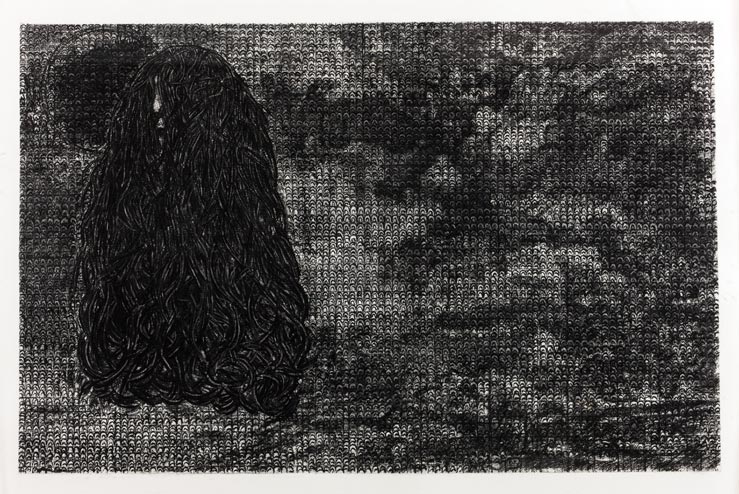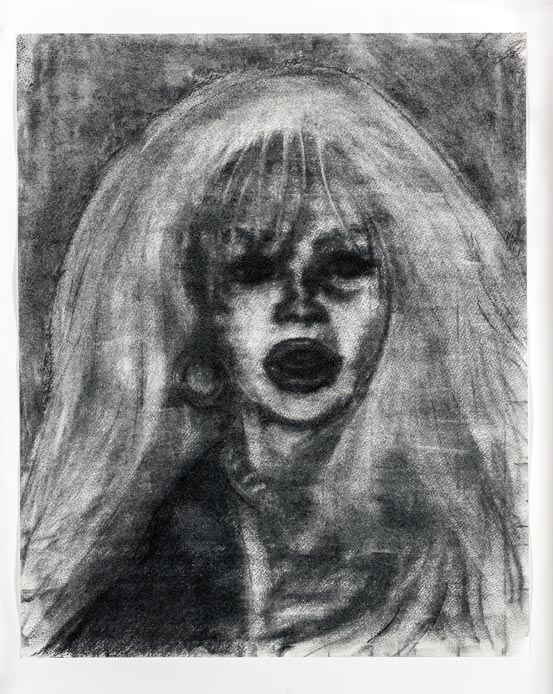Solo: Hello Darkness

Hello Darkness, Kevin Kavanagh Gallery Dublin 2012

Hello Darkness, Kevin Kavanagh Gallery Dublin 2012

Hello Darkness, Kevin Kavanagh Gallery Dublin 2012

Hello Darkness, Kevin Kavanagh Gallery Dublin 2012

Hello Darkness, charcoal on paper 85 X 120 cm

Moran Park, charcoal on paper 113 X 144 cm

Twilight Forest, charcoal on paper 126 X 156 cm

Virus, charcoal on paper 55cms x 66 cm

Algae Bloom, charcoal on paper 125 X 156 cm

Registered Trade Mark, charcoal on paper 54 X 66 cm

Argggh, charcoal on paper 55 X 66 cm

Bad Moon, charcoal on paper 55 X 66 cm

Twilight, charcoal on paper 55cms x 66 cm

The Bridge, ( Just Because you haven’t heard from me ), charcoal on paper 104 cms x 138 cm

Haunted, charcoal on paper 125 X 86 cm

I’ll be your Mirror, charcoal on paper 85 X 120 cms

Final, Final Girl, charcoal on paper 85 xX120 cms

Goddess, charcoal on paper 65 X 75cms
Hello Darkness Press Release
“It might be better to stop talking about the sublime completely seeing that the term has been corrupted beyond recognition by the mumbo jumbo of the high priests of art religion.” Theodore Adorno
“The banal, the quotidian, the obvious, the common, the ordinary, the infa-ordinary the background noise, the habitual? How are we to speak of these common things, how to track them down, how to flush them out, wrest them from the dross in which they are mired, how to give them meaning, a tongue, to let them, finally, speak of what it is, who we are”. Georges Perec
“Don’t think since you haven’t heard from for a while that I went to sleep. No, rather, I am still here. Like a spirit roaming the night. Thirsty, hungry, seldom stopping to rest, anxious to please.” David Berkowitz
Hello Darkness, Gary Coyle’s first one person show in The Kevin Kavanagh Gallery since 2007, sees him return to familiar territory or in Coyle’s case terroir, his everyday environment of South County Dublin which he has explored repeatedly over the past decade, in various exhibitions – Ad Marginem 1999, Death In Dun Laoghaire 2005, Southside Gothic 2007, and At Sea 2010 – and through various media – including photography, drawing, and spoken word performance.
Hello Darkness has taken up where he last left off, namely examining various aspects of the Gothic, sublimes trashier more unstable younger relation, which he has filtered through his neighbourhood, which provides the setting for most of this exhibition. “One of the enduring characteristics of the gothic can be found in its emphasis, on fragmentation, inconsistent narratives and an excess of morphological, disjoined and decentralized forms and shapes,”(1). Many of these elements are explored in Hello Darkness, in the digitally morphed heads proliferating in the sky of “Algae Bloom”, or the virus sweeping through “Twilight Forest”. Some can also be detected in the Final Final Girl, (a modern day Cassandra) a figure Coyle has used before, making what we hope is her last appearance, she has endured untold disasters, and come back from the brink to tell us her news, and its not good. This inconsistent narrative is also an element in the drawing of the hooded track suited figure, (who also featured prominently in previous drawings). Part Friedich’s poet visionary eavesdropping on the end of the world, part Dublin Skobie up to no good, by way of Philip Gustons hooded KKK men, illustrating that classic trope of the Gothic, namely the divided self, hero/villain. This duality is taken up again in “The Bridge” which sees the Berkowitz quote rendered into binary text, (one of the fundamental building blocks of our modern world,) and imbedded into a the drawing of the Stillorgan Dual Carriageway.
Another key tenet of the gothic is the conflict between nature and man, and this tension is played out in various ways through out the exhibition, in the aforementioned “Twilight Forest” and “The Bridge” or the ubiquitous screen, which has taken over the Final Final Girl. In all of these drawings, the natural has largely withdrawn and been replaced by the synthetic, a place where nature is experienced as an image or via a screen, a world in which according to Thomas Mc Elvilly “the technosublme, the culmination of developments in capitalist globalisation will be the terror sublime of the next 50 years”.(2) Scattered through the exhibition are several more straightforward drawings, which attempt to examine the psycho geography off places, which have significance for the artist, Moran park, and The Dual Carriage way, locations to which he has returned to again and again.
So far so serious, at the same time the gothic has always been playful, with its tongue firmly stuck in its cheek, “Almost all art that could be called gothic has an ironic edge, its aware of the absurdity of its position.”(3) and this is apparent in other drawings, “Haunted” – again a vital element of the gothic – sees a ghost, evidently a figure with a sheet over its head posed against a gloomy Southside landscape, another drawing, that of a registered trade mark, mocks the artists gloomy preoccupations, “Arrggggh” sees a man leaping off a high building, at the end of his tether exhausted by the past decades endless rethreading of minutia of high modernism, who’s investigation in some quarters has become almost holy writ.
“Drawing is a testing of ideas, a slow motion version of thought, it does not arrive instantly like a photo. The uncertain and imprecise way of constructing a drawing is sometimes a model of how to construct meaning, what ends in clarity does not begin that way” (4)
(1) Christoph Grunenberg. Gothic: Transmutations of Horror in late 20th Century Art. .
(MIT Press 1997) p 169.
(2) Thomas McEvilley. Turned upside-down & Torn apart. Sticky Sublime Edited Bill
Beckley, (Allworth Press, 2001) p75
(3) Jerry Saltz, Modern Gothic 2004, Village Voice, The Gothic, Edited Gilda Williams,
(Whitechapel London, MIT Press 2007) p 48
(4) William Kent ridge, Carolyn Christov-bakargiev, (Phaidon Press 1999) p 8.
